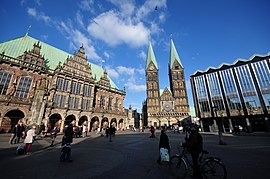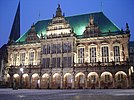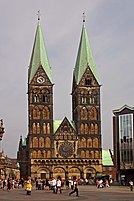
A | B | C | D | E | F | G | H | CH | I | J | K | L | M | N | O | P | Q | R | S | T | U | V | W | X | Y | Z | 0 | 1 | 2 | 3 | 4 | 5 | 6 | 7 | 8 | 9
Bremen
Breem / Bräm (Low German) | |
|---|---|
Clockwise from top: Bremen Market Square; houses on the market square and Bremen Roland Statue; Bremen City Hall; Bremen Cathedral; Town Musicians of Bremen Statue; Schnoor scenery; and Schütting Building | |
| Coordinates: 53°04′33″N 08°48′26″E / 53.07583°N 8.80722°E | |
| Country | Germany |
| State | Bremen |
| Subdivisions | 5 boroughs, 19 districts, 88 subdistricts |
| Government | |
| • Mayor | Andreas Bovenschulte (SPD) |
| • Governing parties | SPD / Greens / Left |
| Area | |
| • City | 326.73 km2 (126.15 sq mi) |
| • Metro | 11,627 km2 (4,489 sq mi) |
| Elevation | 12 m (39 ft) |
| Population (2022-12-31)[1] | |
| • City | 569,396 |
| • Density | 1,700/km2 (4,500/sq mi) |
| • Metro | 2,800,000 |
| Demonym(s) | Bremer (m), Bremerin (f) |
| Time zone | UTC+01:00 (CET) |
| • Summer (DST) | UTC+02:00 (CEST) |
| Postal codes | 28001–28779 |
| Dialling codes | 0421 |
| Vehicle registration | HB (with 1 to 2 letters and 1 to 4 digits)[2] |
| Website | Bremen online |
Bremen (Low German also: Breem or Bräm), officially the City Municipality of Bremen (German: Stadtgemeinde Bremen, IPA: [ˈʃtatɡəˌmaɪndə ˈbʁeːmən] ), is the capital of the German state Free Hanseatic City of Bremen (Freie Hansestadt Bremen), a two-city-state consisting of the cities of Bremen and Bremerhaven. With about 570,000 inhabitants, the Hanseatic city is the 11th largest city of Germany and the second largest city in Northern Germany after Hamburg.
Bremen is the largest city on the River Weser, the longest river flowing entirely in Germany, lying some 60 km (37 mi) upstream from its mouth into the North Sea, and is surrounded by the state of Lower Saxony. A commercial and industrial city, Bremen is, together with Oldenburg and Bremerhaven, part of the Bremen/Oldenburg Metropolitan Region, with 2.5 million people. Bremen is contiguous with the Lower Saxon towns of Delmenhorst, Stuhr, Achim, Weyhe, Schwanewede and Lilienthal. There is an exclave of Bremen in Bremerhaven, the "Citybremian Overseas Port Area Bremerhaven" (Stadtbremisches Überseehafengebiet Bremerhaven). Bremen is the fourth largest city in the Low German dialect area after Hamburg, Dortmund and Essen.
Bremen's port, together with the port of Bremerhaven at the mouth of the Weser, is the second largest port in Germany after the Port of Hamburg. The airport of Bremen (Flughafen Bremen "Hans Koschnick") lies in the southern borough of Neustadt-Neuenland and is Germany's 12th busiest airport.
Bremen is a major cultural and economic hub of Northern Germany. The city is home to dozens of historical galleries and museums, ranging from historical sculptures to major art museums, such as the Bremen Overseas Museum (Übersee-Museum Bremen).[3] The Bremen City Hall and the Bremen Roland are UNESCO World Heritage Sites. Bremen is well known through the Brothers Grimm's fairy tale "Town Musicians of Bremen" (Die Bremer Stadtmusikanten), and there is a statue dedicated to it in front of the city hall.
Bremen has a reputation as a working-class city.[4] The city is home to many multinationals and manufacturing companies headquartered in Bremen include Hachez chocolate and Vector Foiltec.[5] Bundesliga club SV Werder Bremen play in the Weserstadion on the bank of the Weser.
History
For most of its 1,200 year history, Bremen was an independent city within the confederal jurisdiction of Germany's Holy Roman Empire. Its governing merchants and guilds were at the centre of the Hanseatic League that sought to monopolise the North Sea and Baltic Sea trade. To enlarge and confirm its independence, the city had, until the Reformation, to contend with the temporal power of the Church, and after the Thirty Years War with Sweden, the masters of the surrounding Duchy of Bremen-Verden.
In the late nineteenth century, Bremen was drawn by Prussia into the German Empire. With its new sea anchorage and wharves at Bremerhaven, it was the principal port of embarkation for German and central European emigrants to the Americas, and an entrepôt for Germany's late developing colonial trade. The Norddeutscher Lloyd (NDL), founded in Bremen in 1857, became one of the world's leading shipping companies.
In the twentieth century, Bremen, a broadly liberal and social-democratic city, lost its autonomy under the Hitler regime. After World War Two, in which almost two thirds of the city's fabric was destroyed, this was restored. Bremen became one of the founding Bundesländer (or states) of West Germany.
Geography

Bremen lies on both sides of the River Weser, about 60 kilometres (37 miles) upstream of its estuary on the North Sea and its transition to the Outer Weser by Bremerhaven. Opposite Bremen's Altstadt is the point where the "Middle Weser" becomes the "Lower Weser" and, from the area of Bremen's port, the river has been made navigable to ocean-going vessels. The region on the left bank of the Lower Weser, through which the Ochtum flows, is the Weser Marshes, the landscape on its right bank is part of the Elbe-Weser Triangle. The Lesum, and its tributaries, the Wümme and Hamme, the Schönebecker Aue and Blumenthaler Aue, are the downstream tributaries of the Weser.
The city's municipal area is about 38 kilometres (24 miles) long and 16 kilometres (10 miles) wide. In terms of area, Bremen is the eleventh largest city in Germany; and in terms of population the second largest city in northwest Germany after Hamburg and the eleventh largest in the whole of Germany (see: List of cities in Germany).[contradictory]
Bremen lies about 50 kilometres (31 miles) east of the city of Oldenburg, 110 kilometres (68 miles) southwest of Hamburg, 120 kilometres (75 miles) northwest of Hanover, 100 kilometres (62 miles) north of Minden and 105 kilometres (65 miles) northeast of Osnabrück. Part of Bremerhaven's port territory forms an exclave of the City of Bremen.
Hills of Bremen
The inner city lies on a Weser dune, which reaches a natural height of 10.5 metres (34 feet, 6 inches) above sea level at Bremen Cathedral; its highest point, though, is 14.4 metres (47 feet, 3 inches) above sea level and lies to the east at the Polizeihaus, Am Wall 196. The highest natural feature in the city of Bremen is 32.5 metres (107 feet) above sea level and lies in Friedehorst Park in the northwestern borough of Burglesum.[6]: 25 As a result, Bremen has the lowest high point of all the German states.[7]
Climate
Bremen has a moderate oceanic climate (Köppen climate classification Cfb) due to its proximity to the North Sea coast and temperate maritime air masses that move in with the predominantly westerly winds from the Atlantic Ocean. However, periods in which continental air masses predominate may occur at any time of the year and can lead to heat waves in the summer and prolonged periods of frost in the winter. In general though, extremes are rare in Bremen and temperatures below −15 °C (5.0 °F) and above 35 °C (95.0 °F) occur only once every couple of years. The record high temperature was 37.6 °C (99.7 °F) on 9 August 1992, while the official record low temperature was −23.6 °C (−10.5 °F) on 13 February 1940. On 13 October 2018, Bremen recorded its warmest October day on record with 28.6 °C (83.4 °F).[8] However, the astronomer Heinrich Wilhelm Matthias Olbers reported to have measured −27.3 °C on 23 January 1823.[9] Being at some distance from the main North Sea, Bremen still has a somewhat wider temperature range than Bremerhaven that is located on the mouth of Weser.
Average temperatures have risen continually over the last decades, leading to a 0.6 °C (1.1 °F) rise in the mean annual temperature between 1961–90 and 1981–2010 reference periods. As in most parts of Germany, the year 2014 has been the warmest year on record averaging 11.1 °C (52.0 °F), making Bremen the second-warmest German state after Berlin in 2014.[10] While Bremen is located in the comparatively cloudy northwestern part of Germany, there has been a significant increase in average sunshine hours over the last decades, especially in the months of April, May, and July, causing the annual mean to rise by 121 hours between the reference periods of 1961–90 and 1991–2020.[11] This trend has continued over the last 10 years (2011–2020), which average 1680 hours of sunshine, almost 200 hours more than in the international reference period of 1961–90.[12] Nevertheless, especially the winters remain extremely gloomy by international standards with December averaging hardly more than one hour of sunshine (out of 7 astronomically possible) per day, a feature that Bremen shares with most of Germany and its neighbouring countries, though.
Precipitation is distributed fairly even around the year with a small peak in summer mainly due to convective precipitation, i.e. showers and thunderstorms. Snowfall and the period of snow cover are variable; whereas in some years, hardly any snow accumulation occurs, there has recently been a series of unusually snowy winters, peaking in the record year 2010 counting 84 days with a snow cover.[13] Nevertheless, snow accumulation of more than 20 centimetres (8 in) remains exceptional, the record being 68 centimetres (26.8 in) of snow on 18 February 1979.
The warmest months in Bremen are June, July, and August, with average high temperatures of 20.2 to 22.6 °C (68.4 to 72.7 °F). The coldest are December, January, and February, with average low temperatures of −1.1 to 0.3 °C (30.0 to 32.5 °F). Typical of its maritime location, autumn tends to remain mild well into October, while spring arrives later than in the southwestern parts of the country.
| Climate data for Bremen (1991–2020 normals) | |||||||||||||
|---|---|---|---|---|---|---|---|---|---|---|---|---|---|
| Month | Jan | Feb | Mar | Apr | May | Jun | Jul | Aug | Sep | Oct | Nov | Dec | Year |
| Record high °C (°F) | 14.6 (58.3) |
18.5 (65.3) |
23.5 (74.3) |
30.2 (86.4) |
34.4 (93.9) |
34.9 (94.8) |
36.8 (98.2) |
37.6 (99.7) |
33.4 (92.1) |
28.6 (83.5) |
20.1 (68.2) |
16.1 (61.0) |
37.6 (99.7) |
| Mean maximum °C (°F) | 11.3 (52.3) |
12.3 (54.1) |
17.2 (63.0) |
22.4 (72.3) |
26.4 (79.5) |
29.8 (85.6) |
31.4 (88.5) |
31.5 (88.7) |
25.9 (78.6) |
20.5 (68.9) |
15.6 (60.1) |
11.9 (53.4) |
33.4 (92.1) |
| Mean daily maximum °C (°F) | 4.6 (40.3) |
5.6 (42.1) |
9.3 (48.7) |
14.5 (58.1) |
18.3 (64.9) |
21.3 (70.3) |
23.6 (74.5) |
23.3 (73.9) |
19.3 (66.7) |
14.0 (57.2) |
8.6 (47.5) |
5.4 (41.7) |
14.0 (57.2) |
| Daily mean °C (°F) | 2.2 (36.0) |
2.6 (36.7) |
5.2 (41.4) |
9.4 (48.9) |
13.2 (55.8) |
16.2 (61.2) |
18.4 (65.1) |
18.0 (64.4) |
14.3 (57.7) |
10.0 (50.0) |
5.8 (42.4) |
3.1 (37.6) |
9.9 (49.8) |
| Mean daily minimum °C (°F) | −0.5 (31.1) |
−0.5 (31.1) |
1.1 (34.0) |
3.9 (39.0) |
7.5 (45.5) |
10.5 (50.9) |
12.9 (55.2) |
12.6 (54.7) |
9.6 (49.3) |
6.0 (42.8) |
2.8 (37.0) |
0.5 (32.9) |
5.5 (41.9) |
| Mean minimum °C (°F) | −8.8 (16.2) |
−7.9 (17.8) |
−5.1 (22.8) |
−2.8 (27.0) |
0.5 (32.9) |
4.8 (40.6) |
7.6 (45.7) |
7.0 (44.6) |
3.4 (38.1) |
−0.9 (30.4) |
−4.3 (24.3) |
−7.5 (18.5) |
−11.4 (11.5) |
| Record low °C (°F) | −21.8 (−7.2) |
−23.6 (−10.5) |
−18.7 (−1.7) |
−7.6 (18.3) |
−3.5 (25.7) |
0.5 (32.9) |
3.0 (37.4) |
3.4 (38.1) |
−1.2 (29.8) |
−7.8 (18.0) |
−14.1 (6.6) |
−17.5 (0.5) |
−23.6 (−10.5) |
| Average precipitation mm (inches) | 58.4 (2.30) |
43.6 (1.72) |
45.6 (1.80) |
39.5 (1.56) |
49.8 (1.96) |
62.3 (2.45) |
75.3 (2.96) |
69.3 (2.73) |
58.3 (2.30) |
57.1 (2.25) |
51.2 (2.02) |
59.9 (2.36) |
670.3 (26.39) |
| Average precipitation days (≥ 0.1 mm) | 18.1 | 15.0 | 15.1 | 12.8 | 13.9 | 14.5 | 15.5 | 15.5 | 13.9 | 15.8 | 17.0 | 18.2 | 185.4 |
| Average snowy days (≥ 1.0 cm) | 1.4 | 1.2 | 0.5 | 0 | 0 | 0 | 0 | 0 | 0 | 0 | 0.2 | 0.9 | 1.6 |
| Average relative humidity (%) | 86.9 | 83.7 | 78.9 | 72.4 | 71.5 | 73.0 | 73.4 | 75.2 | 80.4 | 85.0 | 88.5 | 88.7 | 79.8 |
| Mean monthly sunshine hours | 47.8 | 69.8 | 120.4 | 182.0 | 213.2 | 204.8 | 213.5 | 198.0 | 151.2 | 109.8 | 53.3 | 40.2 | 1,604 |
| Source 1: NOAA[14] | |||||||||||||
| Source 2: DWD; wetterkontor.de;[15][16] Infoclimat [17] | |||||||||||||
Population
| Year | Pop. | ±% |
|---|---|---|
| 1350 | 10,000 | — |
| 1650 | 25,000 | +150.0% |
| 1811 | 36,630 | +46.5% |
| 1852 | 57,055 | +55.8% |
| 1864 | 70,692 | +23.9% |
| 1871 | 82,969 | +17.4% |
| 1890 | 125,684 | +51.5% |
| 1900 | 161,184 | +28.2% |
| 1910 | 247,437 | +53.5% |
| 1919 | 262,767 | +6.2% |
| 1925 | 295,585 | +12.5% |
| 1933 | 324,189 | +9.7% |
| 1939 | 431,800 | +33.2% |
| 1945 | 366,427 | −15.1% |
| 1951 | 463,049 | +26.4% |
| 1961 | 569,862 | +23.1% |
| 1971 | 594,591 | +4.3% |
| 1981 | 553,261 | −7.0% |
| 1986 | 521,976 | −5.7% |
| 1991 | 552,746 | +5.9% |
| 2001 | 540,834 | −2.2% |
| 2006 | 547,934 | +1.3% |
| 2011 | 544,043 | −0.7% |
| 2016 | 565,719 | +4.0% |
| 2019 | 568,352 | +0.5% |
| Population size may be affected by changes in administrative divisions. | ||
Bremen's economy boomed in line with the West German Wirtschaftswunder of the 1950s and 60s. This saw the growth, and permanent settlement, of a large migrant worker population, drawn largely from Turkey and southern Europe. A new wave immigration occurred after the turn of new century, following the entry of Poland, Bulgaria and other former East Bloc countries into the European Union, and after 2015 with the settlement of refugees from Syria and other war-torn regions. Today Bremen has a population of 567,000 and is the 11th largest city in Germany and 5th largest city by area with area of 318.21 km2 (122.86 sq mi), which makes this city area bigger than Munich.
By the second decade of the century out of a population (including Bremerhaven) of approximately 680,000, over 115,000 had foreign citizenship,[6][18] and nearly twice that number, almost a third of the total population, could be classified as having non-German origin/ethnicity.[19]
Number of minorities in Bremen by nationality as of 31 December 2022:[20]
| Rank | Nationality | Population (31.12.2022) |
|---|---|---|
| 1 | 22,860 | |
| 2 | 17,345 | |
| 3 | 5,370 | |
| 4 | 9,325 | |
| 5 | 9,455 | |
| 6 | 4,215 | |
| 7 | 3,420 | |
| 8 | 4,240 | |
| 9 | 3,170 | |
| 10 | 3,535 | |
| 11 | 2,350 | |
| 12 | 2,460 | |
| 13 | 2,420 | |
| 14 | 2,835 | |
| 15 | 2,470 |
The recent influx has somewhat moderated the tendency toward an accelerated ageing of the population. As it is, more than half the population of the state of Bremen are over 50, and more than a quarter are over 60.[21]
Politics
The Stadtbürgerschaft (municipal assembly) is currently made up of 72 of the 87 legislators of the state legislature, the Bremische Bürgerschaft who reside in the city of Bremen. The legislature is elected by the citizens of Bremen every four years.
Bremen has a reputation as a left-wing city. The port, shipyards and related industries sustained a large and unionised working class. This translated into support for the Social Democrats, considered Bremen's natural governing party. However, in the 1980s mechanization of the port and closure of the city's leading shipbuilder induced an employment crisis and shook the confidence of the party's traditional voter base. The SPD, which had still polled 51% in 1987, lost its effective majority. The once dominant left-liberal vote split, and coalition government became the norm.[22] The state today is governed by a coalition of the Social Democratic Party, The Greens and The Left.
In November 2019 the right-wing group Phalanx 18 was banned by the city-state of Bremen.[23]
One of the two mayors (Bürgermeister) is elected President of the Senate (Präsident des Senats) and serves as head of the city and the state. The current mayor is Andreas Bovenschulte.[24]












